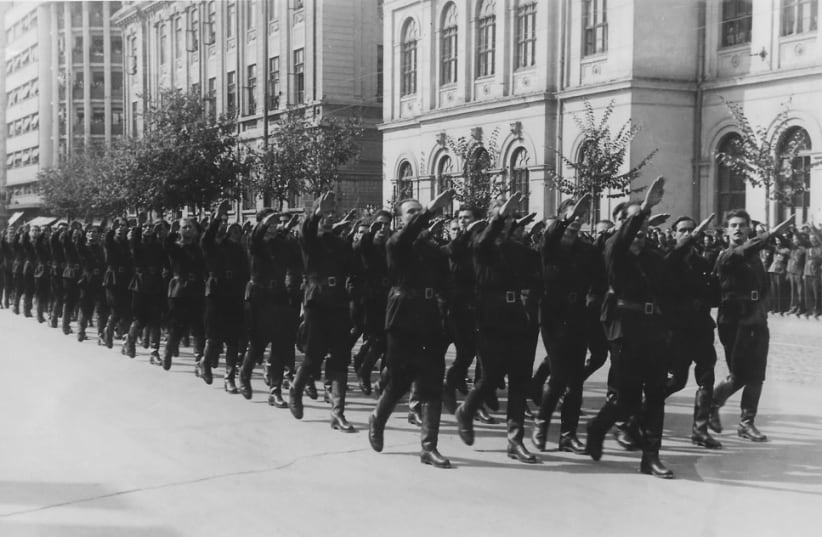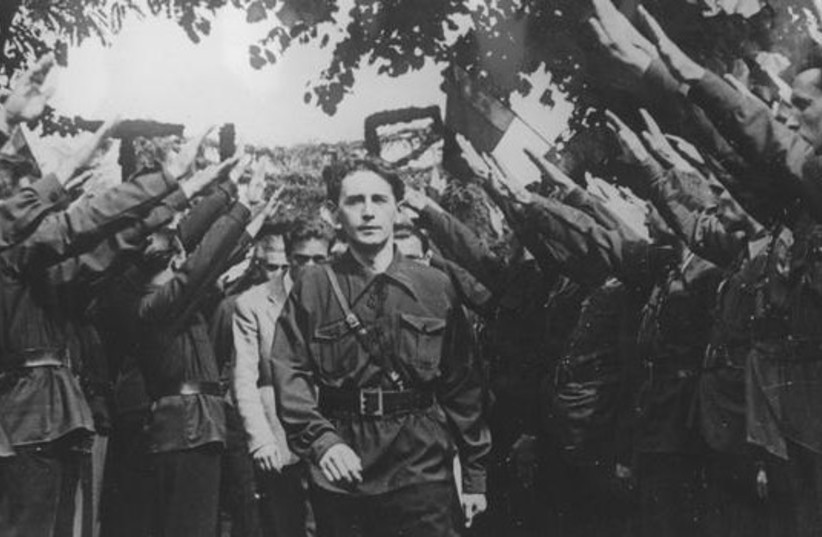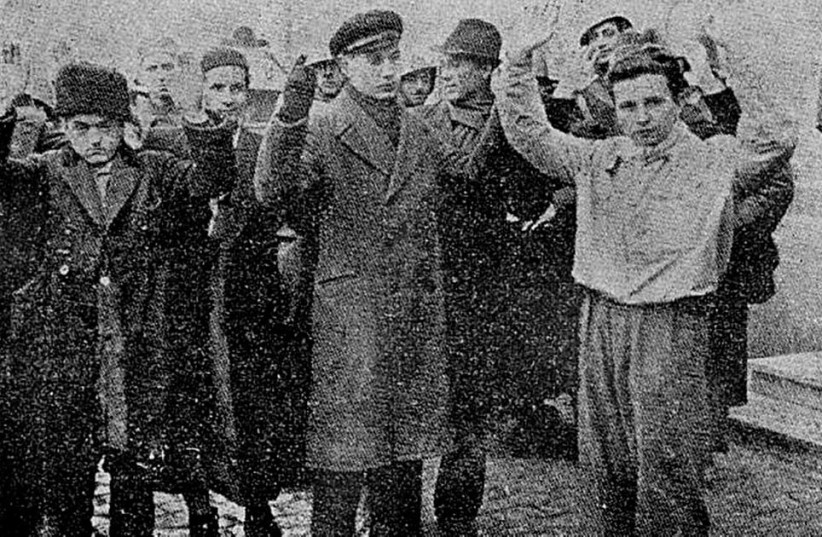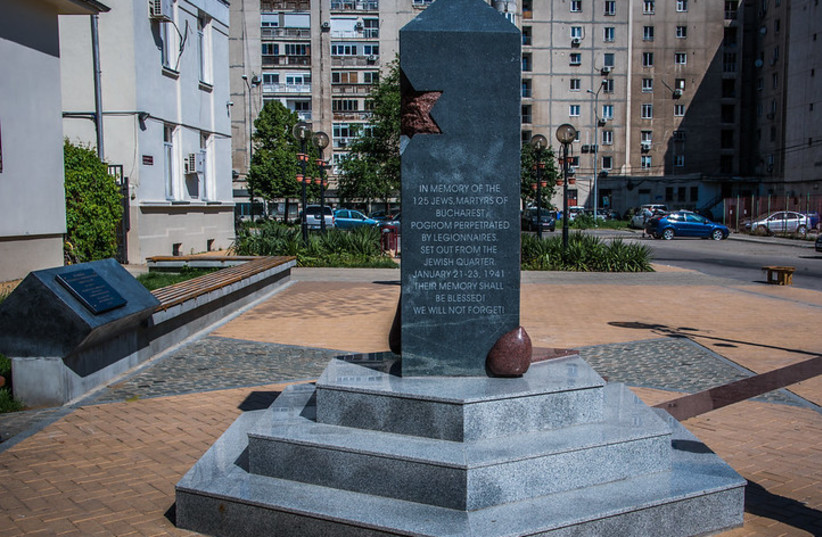January 21, 2022 marks 81 years since legionnaires from the Iron Guard in Romania revolted and carried out a pogrom in Bucharest, killing around 125 Jews during the Holocaust.
During World War II, Romania was ruled by fascist dictator (Conducător) Ion Antonescu, who came to power in 1940. A year earlier, the country had given up certain territories it had gained following World War I. These territories were home to many Jews, who became used as a scapegoat by the state and press amid public dissatisfaction with losing these lands.
Antisemitic policies soon became widespread in Romania, which in turn helped fuel widespread preexisting antisemitic sentiments.
Despite this, Romania was home to a sizeable Jewish community, most of which was concentrated in Bucharest. This continued to grow throughout the war, according to Yad Vashem, as many refugees from throughout the country flocked to the capital, thinking it would be safer.
By January 1941, Bucharest was home to around 100,000 Jews and held the main institutions of the country's Jewish community along with hospitals and schools.
However, the city was also home to a group very hostile towards the Jewish community: The Iron Guard.
This was a nationalist fascist paramilitary organization that was founded in 1927 with a large base among students and peasants. However, it was staunchly antisemitic at its core, with propaganda warning of the dangers of what it had dubbed the "Rabbinical aggression against the Christian world."
In 1941, the Iron Guard's leader Horia Sima held political power alongside Antonescu, but tensions rose between them on a number of issues, most notably the confiscation of Jewish property.
Both men held antisemitic beliefs and were in favor of taking Jewish property. The disagreement, however, was in how it should be taken.
As noted in documents and findings compiled by the United States Holocaust Memorial Museum, the Iron Guard Legionnaires wanted to take everything immediately. This was done through brutal tactics including murder and torture.
By contrast, Antonescu wanted it to be a gradual and orderly process done through the law.
This dispute soon escalated, with the Iron Guard planning a coup and spreading propaganda linking Antonescu to Jews as his stepmother and ex-wife were Jewish.
Antonescu fought back, curbing the Iron Guard's privileges back to weaken them.
Then, after a murder incident saw a dispute over police commander assignments, rebellion erupted. The Iron Guard began storming government buildings and fighting soldiers while the Legionnaires urged the people to rise up and fight.
But while the fighting between Antonescu's forces and the Iron Guard raged, the Legionnaires deliberately began a pogrom against the city's Jews. This served to reinforce their position that Antonescu was allied with Jews and thus making their revolt seem legitimate.
Riots and attacks started against the city's two Jewish boroughs, Dudești and Văcărești, hours before the rebellion itself did. Angry mobs stormed homes and synagogues, Jews were captured and tortured at Iron Guard headquarters. Hoems and neighborhoods were set ablaze as the city's Jews were funneled to specific areas where the men were tortured, women were raped and property was stolen.
Jews were slaughtered at random as well as in planned executions, sometimes thrown out of buildings or killed in slaughterhouses.
As noted by historian Jean Ancel, many women members of the Iron Guard took part in the torture, where they were allegedly behind some of the most horrific acts of torture.
The rebellion, and by extension the pogrom, would last until January 23. But even on the last day, the torture and execution of Jews continued.
In one horrific incident just hours before the rebellion ended, Legionnaires took 15 random Jews to a local slaughterhouse to be shot. But five of these Jews, among them a girl just five years old, were hung on meathooks while still alive, their bellies gutted and entrails hung around their neck as they were labeled "kosher," in reference to Jewish ritual slaughter known as shehita.
There were other Jewish bodies on the meathooks in the slaughterhouse as well, in fact, the sight became arguably the most horrific and iconic part of the pogrom.
Later, US envoy to Romania Franklin Mott Gunther would visit this "slaughterhouse."
In a letter Gunther sent to the US State Department and president Franklin Delano Roosevelt, he noted that an engineer working at the factory "found sixty Jewish corpses on the hooks used for carcasses and all skinned. The quantity of blood about would seem to indicate that they had been skinned alive."
Antonescu was soon able to quell the rebellion and take back control. Notably, none of his soldiers or police officers who supported him took part in any of the atrocities against the Jews during the pogrom.
However, this is not to say that Antonescu was any better. Just months later, he ordered the beginning of the Iași pogrom, a far worse series of brutal purges of Romania's Jewish community that saw over 13,000 Jews massacred. According to the United States Holocaust Memorial Museum, Romania was directly responsible for the murder of more Jews in the Holocaust than any country other than Germany.
The death toll of the Iron Guard's pogrom is said by Yad Vashem to be 127 Jews, though other sources put it at 125 with other sources noting that around 30 soldiers died in the fighting. The number of Iron Guard Legionnaires killed is thought to be between 200-800, but is unclear.
Contemporary accounts painted a far worse picture. According to Gunther, the Turkish ambassador estimated the Jewish death toll at 284 in just the slaughterhouse - an estimate Gunther said was "most conservative in numbers."
Gunther also cited a "reliable Jewish informant of mine" that the city's Jews had applied for 727 burial permits.
These accounts and images show the horror of this pogrom that, while overshadowed by the Iași pogrom months later, remain a terrifying reminder of the atrocities that were committed throughout the Holocaust, when the causes behind these incidents were so unrelated to the actions of the unfortunate victims.
And this horror and revulsion at the events that occurred in late January 1941 in Bucharest were summed up by Gunther.
" It makes one sick at heart to be accredited to a country where such things can happen even though the real faults of inspiration and encouragement lie elsewhere."



